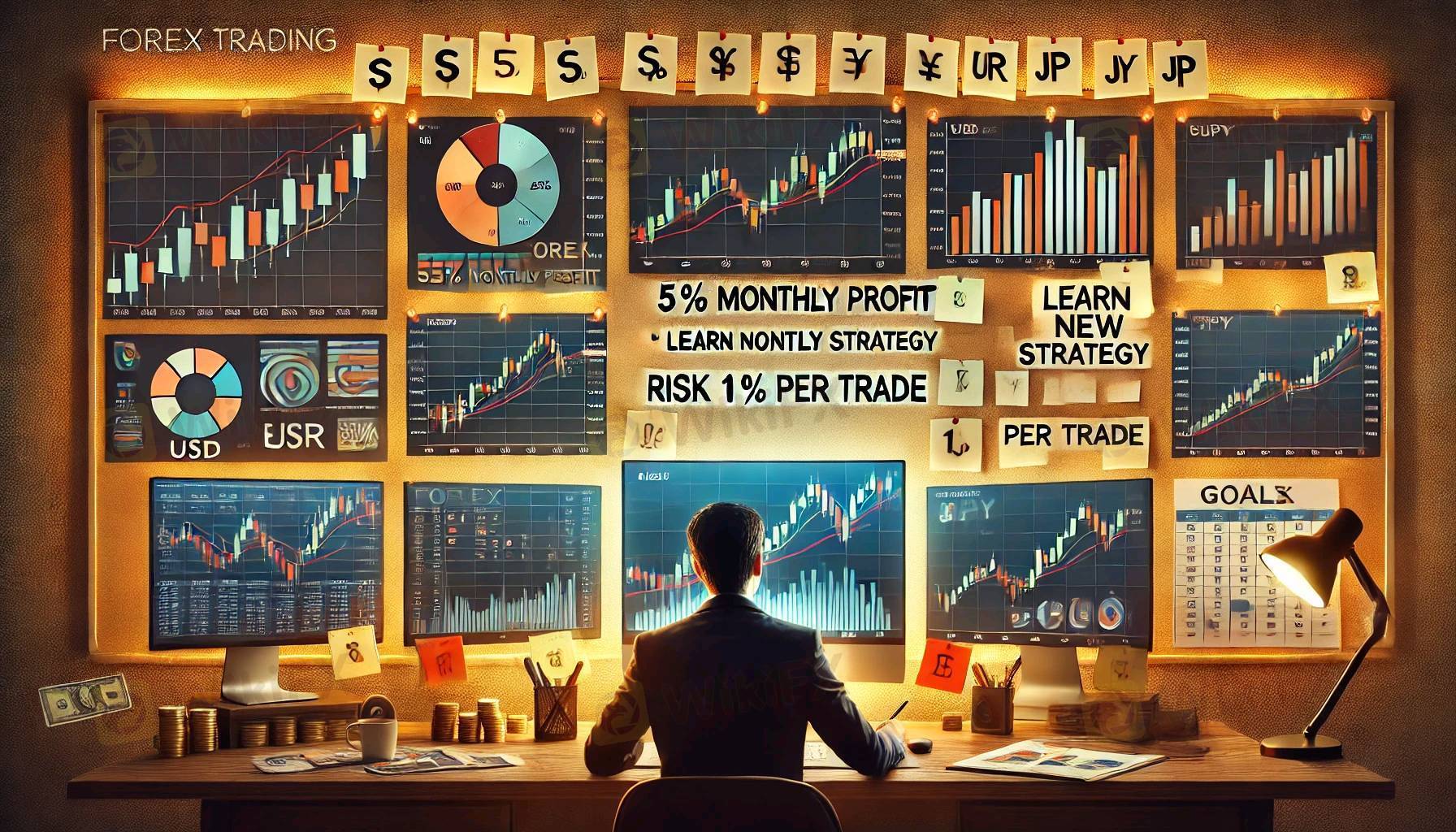
2025-01-30 19:49
業界Defining Trading Goals in forex trading
#firstdealofthenewyearAKEEL
Defining Trading Goals in Forex Trading
Setting clear and achievable trading goals is a critical step for success in Forex trading. Goals provide direction, help measure progress, and keep traders motivated and disciplined. Here’s a structured approach to defining trading goals:
1. Understand Your Motivation
Why do you want to trade Forex?
Generate a steady income?
Build long-term wealth?
Learn and master financial markets?
Identifying your motivation helps shape realistic and personal goals.
2. Set SMART Goals
Specific: Clearly define what you want to achieve.
Example: "Earn 5% profit monthly from Forex trading."
Measurable: Quantify your goals to track progress.
Example: "Spend 10 hours per week learning new trading strategies."
Achievable: Ensure your goals align with your skill level and resources.
Relevant: Set goals that match your broader financial objectives.
Time-bound: Set deadlines to create a sense of urgency.
3. Short-Term vs. Long-Term Goals
Short-Term Goals:
Learn the basics of Forex trading.
Develop and test a trading strategy.
Avoid losing more than a certain percentage of your capital.
Long-Term Goals:
Achieve a consistent monthly profit.
Grow your trading account by a specific percentage annually.
Transition from part-time to full-time trading (if desired).
4. Consider Financial Goals
Decide how much capital you want to start with.
Determine how much you aim to earn within a specific timeframe.
Set realistic expectations for returns, as Forex involves risks.
5. Focus on Skill Development Goals
Improve your understanding of technical and fundamental analysis.
Master one trading strategy before diversifying.
Learn how to manage emotions and trade with discipline.
6. Incorporate Risk Management Goals
Limit risk to 1-2% of your trading capital per trade.
Maintain a risk-reward ratio of at least 1:2.
Develop a plan to handle drawdowns effectively.
7. Evaluate and Adjust Goals Periodically
Review your progress regularly (e.g., monthly or quarterly).
Adapt goals based on new knowledge, experience, and market conditions.
Celebrate small milestones to stay motivated.
Example of Well-Defined Trading Goals:
"Complete a Forex trading course within 3 months."
"Backtest and refine my trading strategy to achieve a win rate of 60% within 6 months."
"Grow my account by 10% in the next year while maintaining a maximum drawdown of 5%."
Final Thoughts
Defining trading goals is not just about making money; it's also about building the skills, discipline, and mindset necessary for long-term success. Start small, track your progress, and refine your approach as you gain experience.
#firstdealofthenewyearAKEEL
いいね 0
Khaleefamb1
Trader
人気の話題
業界
米国株式や日経などのクロスボーダー ETF は大量に高値で償還され
業界
包括的なリスク管理計画を策定する
業界
高度なテクノロジーとテクニカル分析を活用する
業界
📢2025年1月9日11:00の通貨ペア
業界
危険】:米国でVarna Tradeを訪問しましたが、オフィスは見つかりませんでした‼ 詳細は下の画
業界
👀#WikiFX 「先週、日本人ユーザーが最も検索されたFX会社が発表されました!」
市場分類

会社ナビ

エキスポ

IB

募集

EA

業界

相場

指標
Defining Trading Goals in forex trading
 ナイジェリア | 2025-01-30 19:49
ナイジェリア | 2025-01-30 19:49#firstdealofthenewyearAKEEL
Defining Trading Goals in Forex Trading
Setting clear and achievable trading goals is a critical step for success in Forex trading. Goals provide direction, help measure progress, and keep traders motivated and disciplined. Here’s a structured approach to defining trading goals:
1. Understand Your Motivation
Why do you want to trade Forex?
Generate a steady income?
Build long-term wealth?
Learn and master financial markets?
Identifying your motivation helps shape realistic and personal goals.
2. Set SMART Goals
Specific: Clearly define what you want to achieve.
Example: "Earn 5% profit monthly from Forex trading."
Measurable: Quantify your goals to track progress.
Example: "Spend 10 hours per week learning new trading strategies."
Achievable: Ensure your goals align with your skill level and resources.
Relevant: Set goals that match your broader financial objectives.
Time-bound: Set deadlines to create a sense of urgency.
3. Short-Term vs. Long-Term Goals
Short-Term Goals:
Learn the basics of Forex trading.
Develop and test a trading strategy.
Avoid losing more than a certain percentage of your capital.
Long-Term Goals:
Achieve a consistent monthly profit.
Grow your trading account by a specific percentage annually.
Transition from part-time to full-time trading (if desired).
4. Consider Financial Goals
Decide how much capital you want to start with.
Determine how much you aim to earn within a specific timeframe.
Set realistic expectations for returns, as Forex involves risks.
5. Focus on Skill Development Goals
Improve your understanding of technical and fundamental analysis.
Master one trading strategy before diversifying.
Learn how to manage emotions and trade with discipline.
6. Incorporate Risk Management Goals
Limit risk to 1-2% of your trading capital per trade.
Maintain a risk-reward ratio of at least 1:2.
Develop a plan to handle drawdowns effectively.
7. Evaluate and Adjust Goals Periodically
Review your progress regularly (e.g., monthly or quarterly).
Adapt goals based on new knowledge, experience, and market conditions.
Celebrate small milestones to stay motivated.
Example of Well-Defined Trading Goals:
"Complete a Forex trading course within 3 months."
"Backtest and refine my trading strategy to achieve a win rate of 60% within 6 months."
"Grow my account by 10% in the next year while maintaining a maximum drawdown of 5%."
Final Thoughts
Defining trading goals is not just about making money; it's also about building the skills, discipline, and mindset necessary for long-term success. Start small, track your progress, and refine your approach as you gain experience.
#firstdealofthenewyearAKEEL
いいね 0
私もコメントします
質問します
0コメント件数

誰もまだコメントしていません、すぐにコメントします

質問します
誰もまだコメントしていません、すぐにコメントします